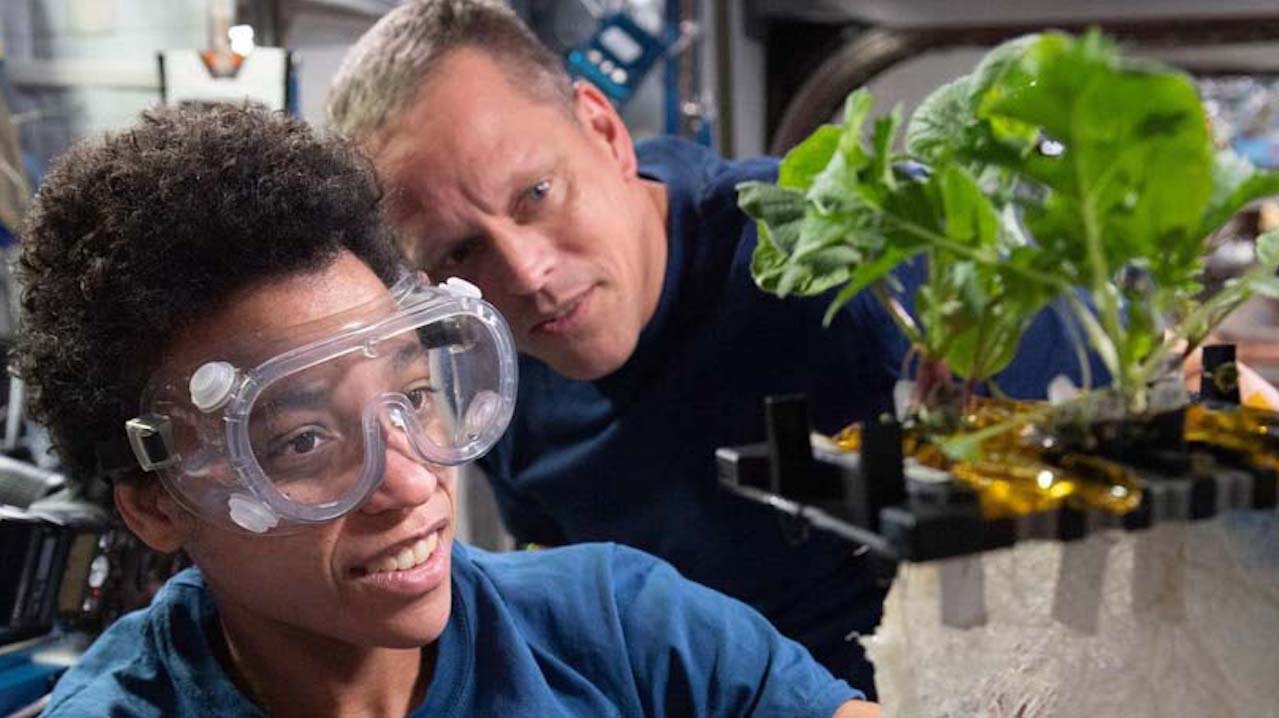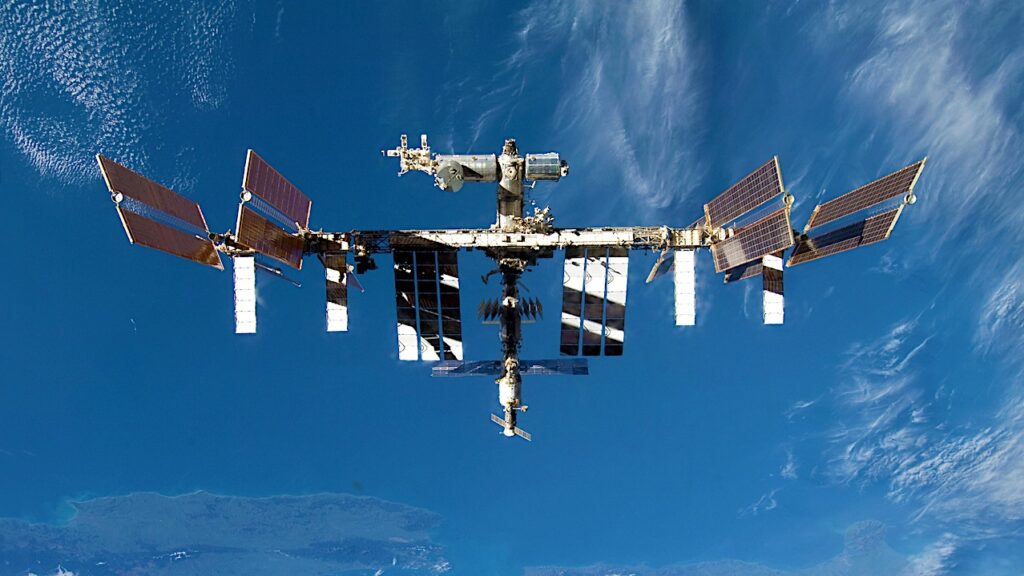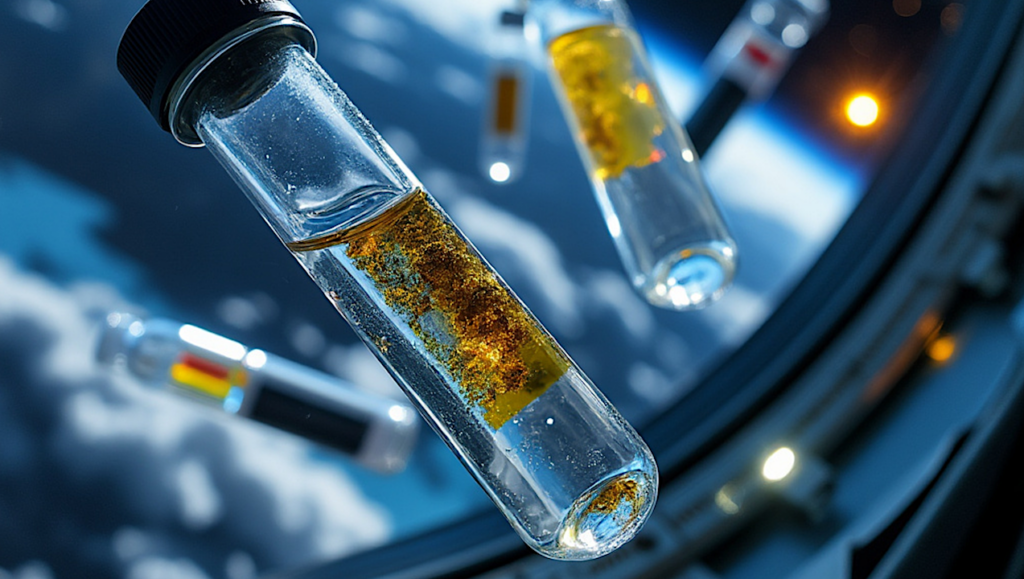NASA Spaceline Current Awareness List #1,116 13 September 2024 (Space Life Science Research Results)

Space Biology conducted aboard the International Space Station — NASA
The abstract in PubMed or at the publisher’s site is linked when available and will open in a new window.
Papers deriving from NASA support:
- Nastasi N, Bope A, Meyer ME, Horack JM, Dannemiller KC.Predicting how varying moisture conditions impact the microbiome of dust collected from the International Space Station.Microbiome. 2024 Sep 10;12(1):171.PI: K.C. DannemillerNote: ISS results. This article may be obtained online without charge.
Journal Impact Factor: 13.8
Funding: “We would like to thank the National Aeronautics and Space Administration (NASA) Space Biology Grant (#80NSSC19K0429) for funding and support for this study. We also greatly appreciate Mark Ott as well as the staff at the NASA Microbiology Laboratory and Toxicology and Environmental Chemistry (TEC) group for their help in obtaining dust samples from the International Space Station.” - Kramer LA, Hasan KM, Zhang X, Mulder E, Gerlach DA, Marshall-Goebel K, Macias BR, Laurie SS, Strangman G, Iyer R, Bershad EM.Artificial gravity: An effective countermeasure for microgravity-induced headward fluid shift?J Appl Physiol (1985). 2024 Sep 12. Online ahead of print.PI: PI NAMESNote: Head-down tilt bedrest study.
Journal Impact Factor: 3.5
Funding: “This study was funded by a grant from the National Aeronautics and Space Administration Human Research Program Grant #NNJ15ZSA001N-AGBR: Studying the Physiological and Anatomical Cerebral Effects of Centrifugation and Head-Down Tilt Bed Rest (SPACE-CENT) (EMB). The DLR contribution to this study was funded by DLR-internal cost object 2475 115. XZ was partially supported by a grant (UL1TR003167) funded by the National Center for Advancing Translational Sciences (NCATS).” - Rice KC, Davis KAT.Confocal microscopy of oral streptococcal biofilms grown in simulated microgravity using a random positioning machine.npj Microgravity. 2024 Sep 9;10(1):89.PI: K.C. RiceNote: This article is a brief communication and may be obtained online without charge.
Journal Impact Factor: 5.1
Funding: “This study was funded by NASA grant 80NSSC18K1463 awarded to Kelly C. Rice. We gratefully thank Dr. Ye Zhang and Dr. Jeffrey Richards at the Microgravity Simulation Support Facility (MSSF), Kennedy Space Center, for support and training with the MSSF RPM hardware and confocal microscope. We also thank Dr. Robert Shields (Arkansas State University) and Dr. Robert Burne (University of Florida) for providing the S. mutans and S. gordonii fluorescent strains used in this study.” - Wieg L, Ciola JC, Wasén CC, Gaba F, Colletti BR, Schroeder MK, Hinshaw RG, Ekwudo MN, Holtzman DM, Saito T, Sasaguri H, Saido TC, Cox LM, Lemere CA.Cognitive effects of simulated galactic cosmic radiation are mediated by ApoE status, sex, and environment in APP knock-in mice.Int J Mol Sci. 2024 Aug 29;25(17):9379.PI: C.A. LemereNote: This article is part of Special Issue “Advanced Science in Alzheimer’s Disease” (https://www.mdpi.com/journal/ijms/special_issues/T2NC66U6RP). The Special Issue also includes an article from previous Current Awareness List #1,114 https://doi.org/10.3390/ijms25168948. This article may be obtained online without charge.
Journal Impact Factor: 4.9
Funding: “This research was funded by a grant from the National Aeronautics and Space Administration (NASA): 80NSSC18K0810 (to C.A.L.).” - Huang W, Morello M, Gholson BA, Lindner JR.Precision medicine in ischemic heart disease through point-of-care myocardial contrast echocardiography.JACC Cardiovasc Imaging. 2024 Sep 4. Online ahead of print.PI: J.R. LindnerJournal Impact Factor: 12.8
Funding: “Dr Lindner is supported by grants R01-HL078610, R01-HL130046, R01-HL165422, and R01-HL101972 from the National Institutes of Health and grant 18-18HCFBP_2-0009 from NASA.” - Polizio AH, Marino L, Min KD, Yura Y, Rolauer L, Cochran JD, Evans MA, Park E, Doviak H, Miura-Yura E, Good ME, Wolpe AG, Grandoch M, Isakson B, Walsh K.Experimental TET2 clonal hematopoiesis predisposes to renal hypertension through an inflammasome-mediated mechanism.Circ Res. 2024 Sep 5. Online ahead of print.PI: K. WalshJournal Impact Factor: 16.5
Funding: “This work was supported by the National Institutes of Health (NIH) grants AG073249, HL142650, HL152174, NASA grant 80NSSC21K0549 and Department of Defense grant CA210887P2 to K. Walsh, the University of Virginia Medical Scientist Training program grant T32GM007267 to J.D. Cochran, and Deutsche Forschungsgemeinschaft (DFG, German Research Foundation; IRTG 1902 Intra- and interorgan communication of the cardiovascular system, TP12, grant no. 220652768 and TRR259 Aortic disease, TP B08, grant no. 397484323 to M. Grandoch.” - Klaeser M, Renata V, Lee JD.Unlocking insights: An interface for understanding dialogue data.Proc Hum Factors Ergon Soc Annu Meet. 2024 Aug 29;10711813241263505. Online ahead of print.PI: J.D. LeeNote: This article is a meeting proceedings that published in peer-reviewed Sage Journals and may be obtained online without charge.
Journal Impact Factor: 3.598
Funding: “The author(s) disclosed receipt of the following financial support for the research, authorship, and/or publication of this article: This work was supported by NASA Human Research Program No.80NSSC19K0654.” - Renata V, Klaeser M, Lee JD.The relevance of seemingly irrelevant group interactions for automation trust: An analysis of naturalistic team conversations on contingent behaviors.Proc Hum Factors Ergon Soc Annu Meet. 2024 Aug 29;10711813241262023. Online ahead of print.PI: J.D. LeeNote: This article is a meeting proceedings that published in peer-reviewed Sage Journals and may be obtained online without charge.
Journal Impact Factor: 3.598
Funding: “The author(s) disclosed receipt of the following financial support for the research, authorship, and/or publication of this article: This work was supported by NASA Human Research Program No.80NSSC19K0654.”
Other papers of interest:
- Jeyaraman M, Ramasubramanian S, Yadav S, Jeyaraman N.Exploring new horizons: Advancements in cartilage tissue engineering under space microgravity.Cureus. 2024 Aug 5;16(8):e66224. Review.Note: This article may be obtained online without charge.
- Samathu JHA, Mani R, Venkatesh V, Vaishnavi A, Sacrapani L.Smile beyond the stars: A narrative review exploring the challenges for dentistry in space.Cureus. 2024 Aug 10;16(8):e66591. Review.Note: This article may be obtained online without charge.
- Zaccarine SA, Klaus DM.Monitoring, maintenance and fault management considerations for self-sufficient deep-space habitat operations.Acta Astronaut. 2024 Sep 7. Online ahead of print.Note: From the abstract: “Deep-space human exploration will necessitate increasing operational autonomy for the crew and habitat as reliance on extensive Earth support becomes impractical. In this context, the habitat and onboard crew must effectively become an ‘autonomous system’ that can operate for finite periods without external intervention from outside a defined control volume, which historically has extended beyond the habitat to include ground facilities, teleoperators, and other space assets. For deep-space exploration missions, however, timely logistical resupply becomes impractical and communication with Earth is delayed, or even impossible at times from occultations. Therefore, to enable the operational autonomy needed to accomplish the overall mission objectives, additional onboard capabilities, which may be facilitated by emerging technologies, will be required to offset decreased Earth-based support and move toward self-sufficiency.”
- Priya K, Deepak KK, Kochhar KP, Anil A, Chandran DS, Sharma S, Jangra S, Netam R.The effect of short-term exposure to lower body positive pressure on motor signal processing, reaction times, and cardiovascular parameters in healthy volunteers using medical anti-shock trousers.Cureus. 2024 Aug;16(8):e66266.Note: From the abstract: “Microgravity, as experienced during spaceflight has notable effects on the cognition and cardiovascular systems. However, its effect on motor signal processing is not known. In this study, we planned to study the effect of microgravity simulation with a lower body positive pressure of 50 mmHg on motor signal processing, reaction times, and cardiovascular parameters.”
- Mu Y, Zhang N, Wei D, Yang G, Yao L, Xu X, Li Y, Xue J, Zhang Z, Chen T.Müller cells are activated in response to retinal outer nuclear layer degeneration in rats subjected to simulated weightlessness conditions.Neural Regen Res. 2025 Jul 1;20(7):2116-28.Note: Hindlimb unloading study. This article may be obtained online without charge.
- Xue Z, Jiang Y, Meng B, Lu L, Hao M, Zhang Y, Shi S, Li Z, Mao X.Apoptotic vesicle-mediated senolytics requires mechanical loading.Theranostics. 2024 Aug 6;14(12):4730-46.Note: Hindlimb unloading study. This article may be obtained online without charge.
- Zhang C, Yuan Y, Zhang S, Yan N, Zhao Y, Lu L, Li K, Zhou S, Cai S, Liang F, Ji G, Qu Y, Lv K, Dai Y, Li B, Yan S, Li X, Qu L, Li Y.Mesenchymal stem cells arouse myocardial NAD+ metabolism to alleviate microgravity-induced cardiac dysfunction.Biochem Biophys Res Commun. 2024 Nov 12;733:150623.Note: Hindlimb unloading study.
- Reynette N, Sagnières L, Pequignot B, Levy B, Zuily S, Chenuel B, Birnbaum R, Sandoz B, Lescroart M.Manual versus automatic chest compression devices for cardiopulmonary resuscitation under zero gravity (The MACCC – 0G STUDY).Resuscitation. 2024 Sep 4:110385. Online ahead of print.Note: From the abstract: “Cardiopulmonary resuscitation (CPR) in microgravity requires specific methods to counteract weightlessness. Automatic chest compression devices (ACCDs) could improve CPR in microgravity. We aimed to compare ACCDs versus manual CPR in microgravity simulated through parabolic flights.”
- Coulombe JC, Bozzini BN, Guerriere KI, Foulis SA, Reynoso M, Walker LA, Staab JS, Bouxsein ML, Hughes JM, Popp KL.Association between changes in serum bone metabolism markers and bone microarchitecture changes during basic combat training – The ARMI study.Bone. 2024 Aug 23;117241. Online ahead of print.Note: From the abstract: “Objective: To characterize bone biomarker changes during Basic Combat Training (BCT) and to investigate the relationship between changes in bone biomarkers and changes in tibial bone mineral density (BMD) and bone structure.”
- Weaver SR, Torres HM, Arnold KM, Zars EL, Peralta-Herrera E, Taylor EL, Yu K, Marron Fernandez de Velasco E, Wickman K, McGee-Lawrence ME, Bradley EW, Westendorf JJ.Girk3 deletion increases osteoblast maturation and bone mass accrual in adult male mice.JBMR Plus. 2024 Aug 4;8(10): ziae108.Note: This article may be obtained online without charge.
- Grönroos M, Jumpponen A, Roslund MI, Nurminen N, Oikarinen S, Parajuli A, Laitinen OH, Cinek O, Kramna L, Rajaniemi J, Hyöty H, Puhakka R, Sinkkonen A.Using patterns of shared taxa to infer bacterial dispersal in human living environment in urban and rural areas.Appl Environ Microbiol. 2024 Sep 4:e0090324. Online ahead of print.Note: From the abstract: “Contact with environmental microbial communities primes the human immune system. Factors determining the distribution of microorganisms, such as dispersal, are thus important for human health. Here, we used the relative number of bacteria shared between environmental and human samples as a measure of bacterial dispersal and studied these associations with living environment and lifestyles.” This article may be obtained online without charge.
- Veseli I, DeMers MA, Cooper ZS, Schechter MS, Miller S, Weber L, Smith CB, Rodriguez LT, Schroer WF, McIlvin MR, Lopez PZ, Saito M, Dyhrman S, Eren AM, Moran MA, Braakman R.Digital microbe: A genome-informed data integration framework for team science on emerging model organisms.Sci Data. 2024 Sep 4;11:967.Note: From the abstract: “The remarkable pace of genomic data generation is rapidly transforming our understanding of life at the micron scale. Yet this data stream also creates challenges for team science. A single microbe can have multiple versions of genome architecture, functional gene annotations, and gene identifiers; additionally, the lack of mechanisms for collating and preserving advances in this knowledge raises barriers to community coalescence around shared datasets. ‘Digital Microbes’ are frameworks for interoperable and reproducible collaborative science through open source, community-curated data packages built on a (pan)genomic foundation.” This article may be obtained online without charge.
- Kato T, Ogawa Y, Iwasaki KI.Effects of the angle of head-down tilt on dynamic cerebral autoregulation during combined exposure to cephalad fluid shift and mild hypercapnia.Front Physiol. 2024 Sep 09;15:1435448.Note: Head-down tilt bedrest study. This article may be obtained online without charge.
- Ward K, Mulder E, Frings-Meuthen P, O’Gorman DJ, Cooper D.The effect of 60 days of 6° head-down-tilt bedrest on circulating adropin, irisin, retinol binding protein-4 (RBP4) and individual metabolic responses in young, healthy males.Front Physiol. 2024 Sep 09;15:1435448.Note: Head-down tilt bedrest study. This article may be obtained online without charge.
- Hoschlova E, Bahbouh R, Huzva M, Chroustova E, Bernardova Sykorova K.Structure and dynamics of crew communication in three stages of the SIRIUS experiment.Acta Astronaut. 2024 Sep 7. Online ahead of print.Note: From the abstract: “This paper aims to present a series of analyses of the structure and dynamics of communication in the SIRIUS 2017-2023 experiments and to compare quantitatively and qualitatively its three stages. Each of them involved a distinct team and each had a different total duration of isolation.”
- Dey A, Jagadanandan J.A common law in space for public health.Acta Astronaut. 2024 Sep 12. Online ahead of print.
Astrobiology, Space Biology, Space Medicine,








